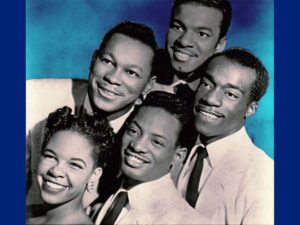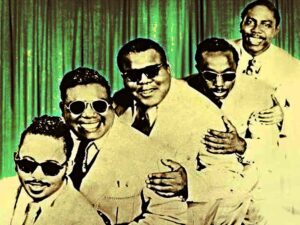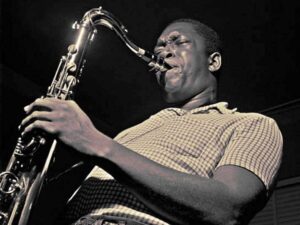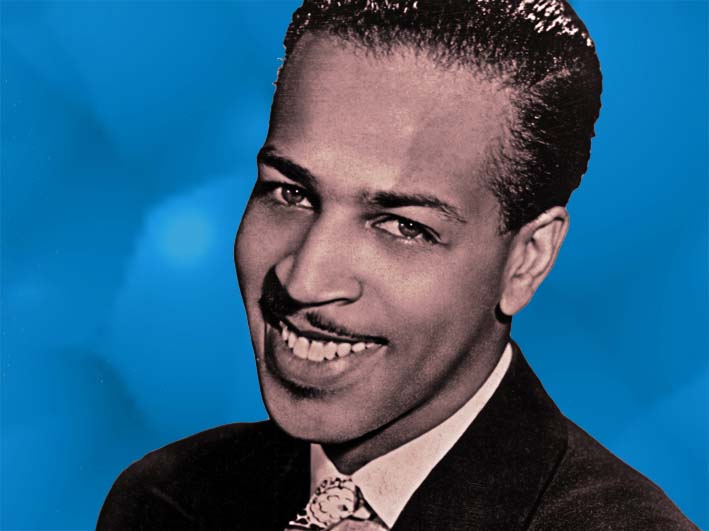MUSIC GENRE ∙ Folk ∙ Rock ∙ RnB SOUL ∙ Rap ∙ Pop Hits ∙ World music ∙
RnB 50s
JOURNEY THROUGH 800 RnB SOUL SONGS
RnB SOUL ∙ 1920-40s ∙ 50s ∙ 60s ∙ 70s ∙ 80s ∙ 90s ∙ Neo Soul 2000s-2010s ∙
RnB 50s

RnB 50s : The Platters (1952-1968) ∙ Ray Charles (1930-2004) ∙ Sam Cooke (1931-1964)
In the late 1940s, the term Rythm 'n' Blues (RnB) became the trade designation for the music of Afro-American communities. As such, RnB was the music scene where the most modern, popular and high-profile musical styles developed as a result of the aforementioned evolution. Throughout the 50s, its most successful subgenres were RnB vocals, RnB rock, modern gospel, blues and jazz.
The advent of rock’n’roll in 1948-49 did not only revolutionize American folk and country music but also blues and popular vocals and gospel, while marking the end of the era for swing-jazz, big band jazz and boogie-woogie. In the following years, each of these musical genres integrated in its own way the moods, rhythms and instruments of rock music.
In the 1950s, RnB vocals followed the musical style pioneered in the 1930s by The Mills Brothers and supported by the advances made in the 40s on the crooner scene by jazz singer Nat King Cole. It spawned the doo-wop frenzy in the mid-50s with serial hits by new bands like The Platters, Frankie Lymon & the Teenagers, The Moonglows, The Five Satins, The Coasters.

The Platters

The Coasters

Sam Cooke
∙ 1950/51 ∙ Mona Lisa / Too young (ver 1961) (Nat King Cole) ∙ 1951/52 ∙ I wonder who's kissing her now / Baby won't you please come home (Ray Charles) ∙ 1951 ∙ Fool fool fool (The Clovers) ∙ 1952 ∙ The glow-worm (The Mills Brothers) ∙ 1953 ∙ Crying in the Chapel (The Orioles) ∙ 1953/54 ∙ Shake a hand / Somebody somewhere (Faye Adams) ∙ 1954 ∙ Earth angel (The Penguins) ∙
∙ 1955 ∙ Only you (The Platters) ∙ That's all I want from you (Dinah Washington) ∙ Whatever Lola wants, Lola gets (Sarah Vaughan) ∙ 1956 ∙ In the still of the night (The Five Satins ft Fred Parris) ∙ Why do fools fall in love (Frankie Lymon & the Teenagers) ∙ Over and over again (The Moonglows) ∙ Love is strange (Mickey & Sylvia) ∙ If you only knew (Jimmy Scott) ∙
∙ 1957/59/60 ∙ You send me / Only sixteen / Chain gang (Sam Cooke) ∙ Over the mountain, accross the sea (Johnnie and Joe) ∙ 1958 ∙ Little bitty pretty one (Frankie Lymon) ∙ Book of love (The Monotones) ∙ Get a job (The Silhouettes) ∙
∙ 1959 ∙ What a difference a day made (Dinah Washington) ∙ A hole in the bucket (Harry Belafonte & Odetta) ∙ Shout (The Isley Brothers) ∙ There goes my baby (The Drifters ft Ben E. King) ∙ Tears on my pilow (Little Anthony) ∙ It's just a matter of time (Brook Benton) ∙ 1959/60 ∙ Three cool cats / Charlie Brown (The Coasters) ∙ Handyman / Wondrous place (Jimmy Jones) ∙
Ruth Brown and Ray Charles were the main movers of RnB rock in the early 1950s. Alongside the rockabilly frenzy developing in white communities, young African-American artists were breathing new style and new life, the most notable being successively Bo Diddley, Chuck Berry, Little Richard and James Brown (see also Rock USA 50s).

Ruth Brown

Bo Diddley

Ray Charles

Chuck Berry

The Drifters

Little Richard
∙ 1950 ∙ Teardrops from my eyes (Ruth Brown) ∙ Cupid's boogie (Esther Phillips & Mel Walker) ∙ 1951 ∙ Rocket 88 (Ike Turner & Jackie Brenston) ∙ Sixty minute man (Billy Ward & The Dominoes) ∙ How many more years (Howlin' Wolf) ∙ 1952 ∙ Ring-a-ding-doo (Johnny Otis & Esther Phillips) ∙ 1952/54 /59 ∙ Kissa me baby / I got a woman / What'd I say (Ray Charles) ∙
∙ 1953 ∙ Money honey (Clyde McPhatter & the Drifters) ∙ Mistery train (Junior Parker) ∙ Tiger man, king of the jungle (Rufus Thomas Jr.) ∙ 1954 ∙ Boogie disease (Doctor Ross) ∙ Shake rattle' roll (Big Joe Turner) ∙ Work with me Annie (Hank Ballard & The Midnighters) ∙
∙ 1955 ∙ Pretty thing (Bo Diddley) ∙ Ain't that a shame (Fats Domino) Maybellene (Chuck Berry) ∙ Wallflower (roll with me Henry!) (Etta James & The Peaches) ∙ 1956 ∙ Tutti frutti / Long tall Sally / Ready Teddy (Little Richard) ∙ Please please please (James Brown & the Famous Flames, ver. 1964) ∙ That's right (Deep River Boys) ∙
∙ 1957 ∙ Little bitty pretty one (Thurston Harris) ∙ Bony Moronie (Larry Williams) ∙ 1958 ∙ Sweet little sixteen / Johnny B goode (Chuck Berry) ∙ Rock 'n' roll call (The Treniers) ∙ Litle bitty pretty one (Frankie Lymon) ∙ Rockin' Robin (Bobby Day) ∙ 1959 ∙ That's why (I love you so) (Jackie Wilson) ∙ Money that's what I want (Barrett Strong) ∙ Jump children (The Flamingos) ∙
Building on the genre's success in the previous decade, avant-garde gospel musicians of the 1950s laid the foundations for modern RnB styles of vocal pop song, doo-wop and soul music.
From 1951 to 1957 ‘The Soul Stirrers’ enjoyed a string of hits with their new young tenor Sam Cooke, who then launched a solo pop career and delivered a stellar run of 30 popular hits from 1957 to 1964. In 1950, while still dedicated to the a capella genre, the group "The Five Blind Boys From Mississippi" performed a hard-gospel style that pushed vocal performance to extremes that were later taken up by James Brown and became the hallmark of soul-funk. In 1952, although assuming their incumbent gospel origin and culture, 'The "5" Royales' adopted jazz-rock instrumentation and quickly became an 'ex-gospel' group worthy representative of modern RnB trend. The 1956 iconic song Uncloudy Day by family group 'The Staple Singers' builds a remarkable bridge between gospel, blues and popular RnB.

The Soul Stirrers ft Sam Cooke

Five Blind Boys Of Mississippi

The "5" Royales
∙ 1950 ∙ Our father (Five Blind Boys Of Mississippi) ∙ Livin' on Mother's prayers (Five Blind Boys Of Alabama) ∙ Jesus gave me water (The Famous Blue Jay Singers) ∙ 1951 ∙ Jesus gave me water (The Soul Stirrers ft Sam Cooke) ∙
∙ 1952/53/57 ∙ Baby don't do it / Help me somebody, crazy crazy crazy / Dedicated to the one I love (The 5 Royales) ∙ 1953/55 ∙ A sinner's plea / Somewhere to lay my head (The Sensational Nightingales) ∙ 1954 ∙ Dreaming of the Ladies in the moon (The Jubalaires) ∙ 1956 ∙ Drown in my own tears (Ray Charles) ∙
∙ 1956/60 ∙ Uncloudy day / Will the circle be unbroken (The Staple Singers) ∙ 1958 ∙ Joshua fit the battle of Jericho / Lord, don't move the mountains (Mahalia Jackson) ∙ Wade in the water (The Drinkard Singers) ∙ Oh Mary don't you weep (Swan Silvertones) ∙ 1959 ∙ Waterboy (Odetta) ∙
.. gospel-sourced RnB Soul carried on, e.g.:
∙ 1966/71 ∙ I'm going to serve the Lord / Groovin' with Jesus (The Violinaires) ∙ 1973 ∙ Striving (The Soul Stirrers) ∙
Gospel revival, a 2010 CD+DVD Combo with 26 Gospel clips: "How sweet it was, the sights and sounds of Gospel's golden age"
In the 50s, traditional blues continued while RnB blues modernized the genre and spread, with Ray Charles reshuffling its codes, Screaming Jay Hawkins turning it into spectacular popular acts and B. B. King shaping elaborate jazzy blues-rock. A number of songs promoted the genre's mass popularity and have since become classics such as :
-
- Crawling king snake ∙ 1941 ∙ Big Joe Williams ∙ Tony Hollins ∙ 1949 ∙ John Lee Hooker ∙ 1971 ∙ Muddy Waters ∙ The Doors ∙
- Hound dog ∙ 1953 ∙ Big Mama Thornton ∙ 1956 ∙ Elvis Presley 1956 ∙ 1963 ∙ Pat Boone ∙ 1989 ∙ Eric Clapton ∙
- On the road again ∙ 1953 ∙ Floyd Jones ∙ 1968 ∙ Canned Heat ∙ 1978 ∙ Les Rockets ∙
- Dimples ∙ 1956 ∙ John Lee Hooker ∙ 1964 ∙ The Animals ∙ Spencer Davis Group ∙
- I pity the fools ∙ 1961 ∙ Bobby Blue Bland ∙ 1965 ∙ David Bowie ∙ 1972 ∙ Ann Peebles ∙

Muddy Waters

John Lee Hooker

B.B. King
TRADITIONAL BLUES
∙ 1950 ∙ Rollin' stone (Muddy Waters) ∙ 1951 ∙ 3 O'clock blues (B.B. King) ∙ She left me a mule to ride (Big Joe Williams, ver. 1966) ∙ How many more years (Howlin' Wolf) ∙ 1952 ∙ When I'm gone (Joe Hill Louis) ∙ 1954 ∙ Boogie disease (Doctor Ross) ∙ 1955 ∙ That's what they want (Jerry McCain) ∙ My babe (Little Walter) ∙ 1958 ∙ Nobody knows you when you're down and out (Scrapper Blackwell) ∙ 1959 ∙ Shake'em on down (Mississippi Fred McDowell) ∙
RnB BLUES
∙ 1950/51/52 ∙ See see rider / Baby let me hold your hand / I'm wondering and wondering (Ray Charles) ∙ 1952 ∙ I believe (Elmore James) ∙ 1953 ∙ Why did you waste my time (Screamin' Jay Hawkins) ∙ The things that I used to do (Guitar Slim) ∙ Hound dog / Hound dog live (Big Mama Thornton) ∙ Mistery Train (Junior Parker) ∙ On the road again (Floyd Jones) ∙ 1954 ∙ Cotton's crop blues (James Cotton) ∙ Thank you for your kindness (J.B. Hutto) ∙ High and lonesome (Jimmy Reed) ∙ 1954/56 ∙ Bad Boy / Dimples (ver. 1997) / Maudie (ver. 1968) (John Lee Hooker) ∙
∙ 1955 ∙ Everyday I have the blues (B.B. King) ∙ 1956 ∙ I put a spell on you (Screamin' Jay Hawkins) ∙ I can't quit you baby (Otis Rush, ver. 70s) ∙ Keep it to Yourself (ver. 1963) (Sonny Boy Williamson) ∙ 1957 ∙ I'm a King bee (Slim Harpo) ∙ 1958 ∙ Stone crazy (Buddy Guy) ∙ 1959 ∙ Come go with me/Lightnin's blues (Lightnin' Hopkins) ∙ She left me a mule to ride (Big Joe Williams, ver. 1966) ∙
As swing jazz and big bands gradually lost popularity in the 1950s, modern jazz evolved into instrumental jazz and cool jazz. Highly appreciated both technically and artistically but with a more restricted audience, jazz became a distinctive segment of the RnB world figuring a somewhat confidential and complex musical segment. Charlie Parker died in 1955 at the age of 34 while Miles Davis continued his rise. The new trendsetters were saxophonist John Coltrane, pianists Oscar Peterson, Eroll Garner, Horace Silver, Ahmad Jamal and free jazz pioneers Cecil Taylor, Ornette Coleman, Eric Dolphy and Charlie Mingus.

John Coltrane

Oscar Peterson

Charlie Mingus
MODERN JAZZ, INSTRUMENTAL, COOL JAZZ
∙ 1950 ∙ I found my way to wine (Lloyd "Tiny" Grimes) ∙ 1951 ∙ Night train (Jimmy Forrest) ∙ Safari (Horace Silver) ∙ 1953 ∙ Motel (Chet Baker & Gerry Mulligan) ∙ 1954 ∙ King of the tenors (Ben Webster) ∙ 1954/57 ∙ Misty / Dreamy (ver. 1964) (Eroll Garner) ∙ 1955 ∙ As long as I live (Oscar Peterson) ∙ Urbanity (full "1947-1955 LP" 32') (Hank Jones) ∙ 1957 ∙ Violets for your furs / Time was (John Coltrane) ∙ 1957/58/59 ∙ Round Midnight / Lift to the Gallows (soundtrack 26') / So what ? (Miles Davis) ∙ 1958 ∙ Poinciana (Ahmad Jamal) ∙ Cute (Count Basie ft Frank Wess) ∙ Me and the blues (Ray Bryant) ∙ Autumn leaves (Cannonball Adderley, orig. 1950 Yves Montand) ∙ 1958/59 ∙ Moanin' / Africaine (ft Wayne Shorter) (Art Blakey's Jazz Messengers) ∙
FREE JAZZ
∙ 1957 ∙ Charge 'em blues (Cecil Taylor) ∙ 1958 ∙ Something else (Ornette Coleman) ∙ 1959 ∙ I'm beginning to see the light (Chico Hamilton ft Eric Dolphy) ∙ Moanin' (Charlie Mingus) ∙
VOCALS JAZZ
∙ 1951 ∙ Blue skies (Joe Caroll) ∙ 1957 ∙ I can't give you anything but love / Air mail special (orig. 1941 Benny Goodman) (Ella Fitzgerald) ∙ 1959 ∙ Strange fruit (Billie Holiday) ∙ My baby just cares for me (Nina Simone) ∙ Umbrella (Louis Armstrong & Dizzy Gillespie) ∙ Are you havin' any fun? (Count Basie ft Tony Benett, orig. 1939 Tommy Dorsey) ∙






















